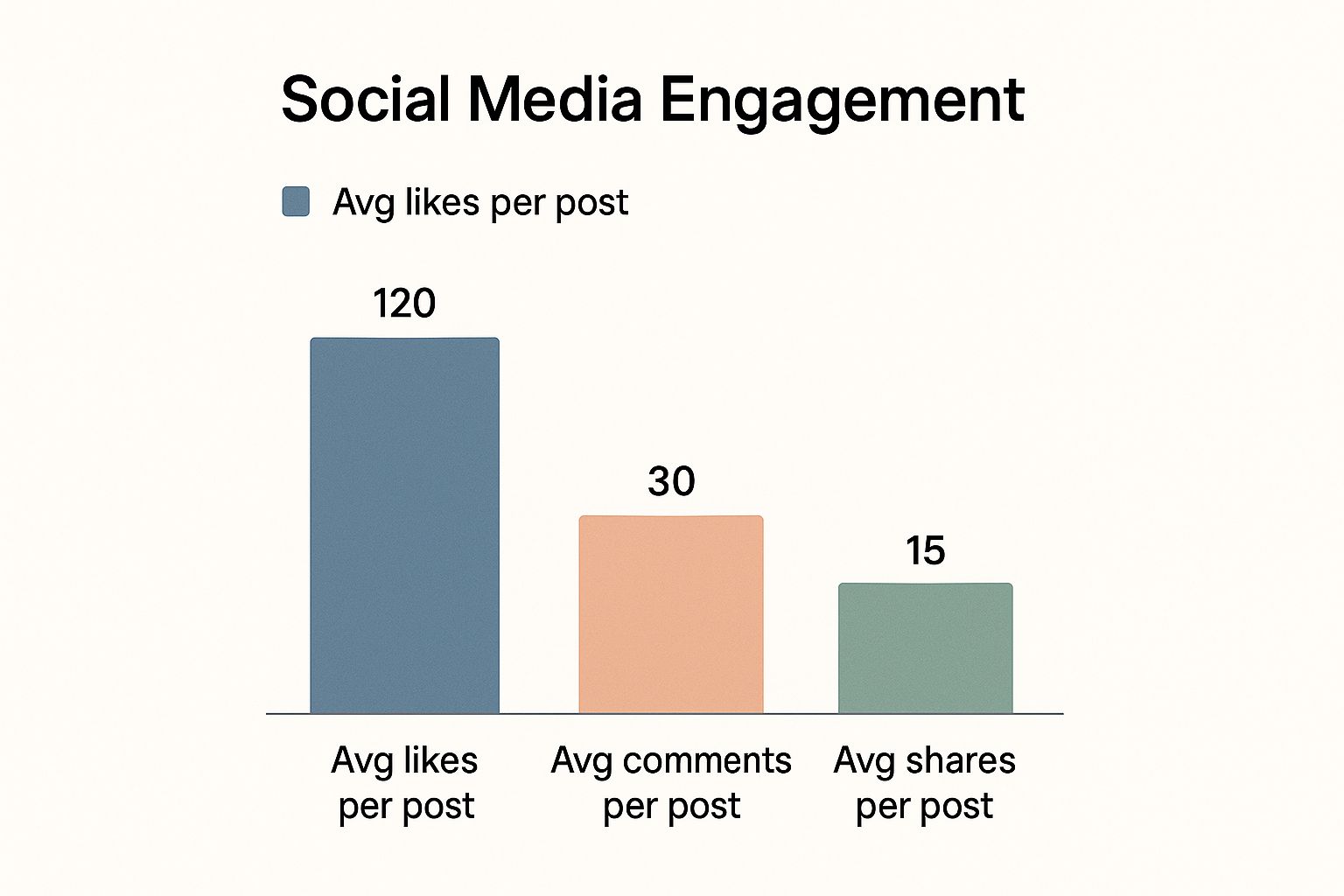If you want to increase social media engagement, you need to stop thinking like a broadcaster and start acting like a community builder. This isn't about collecting passive metrics like likes anymore. It’s about sparking real, meaningful conversations that build trust and make your audience feel like they're part of something significant.
Beyond Likes: Redefining Social Media Engagement
For a long time, marketers were conditioned to chase vanity metrics. A large follower count and a high number of likes were seen as the gold standard for social media success. But those days are over. The landscape has evolved, thanks to smarter algorithms and audiences who expect genuine interaction. Today, the real currency is authentic engagement—comments, shares, saves, and direct messages.
This shift stems from a simple human truth: people crave connection, not just another advertisement. They want to follow brands that feel authentic, that respond to their questions, and that provide genuinely useful content. Simply posting and disappearing is a guaranteed way to be ignored. To succeed, you must be an active, present member of the community you’re aiming to build.
Understanding the Modern User
The sheer scale of social media makes this change impossible to ignore. In 2025, we're looking at around 5.45 billion social media users worldwide. That's a staggering 67.1% of the global population. These users aren't just scrolling passively. The average person spends about 2 hours and 24 minutes a day across approximately seven different platforms.
Their motivations vary widely. Nearly 49% use social media to keep up with friends and family, 34% use it to follow news, and over 25% are actively searching for product ideas. The brands that understand this—the ones that can blend personal connection with valuable content—are the ones that will come out on top. Exploring data on user behavior can significantly sharpen your strategy.
This image effectively illustrates which actions hold the most weight.

As you can see, a 'like' is a low-effort tap. However, a comment or a share requires thought and intent. It indicates someone was genuinely moved by your content, and that’s a signal you can't buy.
The New Cornerstones of Engagement
So, how do you put this into practice? It all boils down to three core principles that should form the foundation of your social media activity.
- Authentic Connection: Let your audience see the humans behind the logo. Share behind-the-scenes content, introduce your team, and adopt a relatable brand voice, not a corporate one.
- Value-Driven Content: Every post must serve a purpose for your audience. Are you solving a problem, answering a common question, teaching a new skill, or simply providing entertainment? If it doesn’t offer value, it’s just noise.
- Active Participation: Don't be a wallflower at your own party. When someone comments, reply with a thoughtful answer, not just an emoji. Ask follow-up questions and join relevant conversations happening in your niche.
The goal is to transform your social media channels from a digital billboard into a community hub. When your audience feels seen, heard, and valued, their loyalty and engagement will follow naturally.
Ultimately, learning how to increase social media engagement isn't about a secret hack or a magic posting schedule. It's about a fundamental shift to a people-first mindset, where you focus on building lasting relationships rather than chasing fleeting numbers.
Platform Engagement Focus Cheat Sheet
To maximize your efforts, you need to understand why people use each platform. A strategy that works wonders on Instagram might fall completely flat on LinkedIn. This table breaks down the user mindset for each major network, enabling you to tailor your content for maximum impact.
PlatformPrimary User IntentOptimal Content for EngagementInstagramVisual discovery, inspiration, and social connection.High-quality images/videos, Reels, Stories, behind-the-scenes content.FacebookConnecting with community, family, and friends; news consumption.Community-building posts, event promotion, long-form video, user-generated content.X (Twitter)Real-time news, trending topics, and quick conversations.Breaking news, quick takes, polls, joining trending conversations with hashtags.LinkedInProfessional networking, industry news, and career development.Thought leadership articles, company news, case studies, professional insights.TikTokEntertainment, trends, and creative, short-form video.Entertaining/educational short videos, participating in trends, duets/stitches.PinterestDiscovery, planning, and shopping for ideas and products.High-quality vertical images, "how-to" guides, infographics, product pins.
Remember, this is a starting point. The key is to treat each platform as its own unique ecosystem and create content that feels native to the environment and speaks directly to the audience's expectations.
Create Content That Sparks Real Conversations

Knowing why engagement matters is one thing; creating content that actually gets people talking is another. The secret is to stop thinking like a broadcaster and start acting like a conversation starter. In a digital world filled with automated posts, algorithms are rewarding genuine human connection.
This means every piece of content you post should have one clear goal: to invite people to participate. Simply pushing information into the void is no longer effective. You need to create experiences that make your audience feel seen, heard, and valued. This is a non-negotiable step if you’re serious about learning how to increase social media engagement for the long term.
Go Beyond Static Posts with Interactive Formats
A traditional image-and-text post still has its place, but to truly ignite your engagement, you must embrace interactive formats. These tools don't just talk at your audience; they pull them into the narrative.
Consider trying these:
- Polls and Quizzes: These are invaluable. They require minimal effort from your followers but provide significant insight. Use them on LinkedIn or Instagram Stories to ask about industry challenges, content preferences, or even fun, brand-adjacent questions. For instance, a B2B SaaS company could run a poll: "Which of these integrations would save you the most time each week?"
- "Ask Me Anything" (AMA) Sessions: Host a live AMA or use Instagram Stories to feature a company leader or an in-house expert. This simple act breaks down the corporate facade, puts a human face on your brand, and allows you to answer the exact questions your audience is grappling with.
- Interactive Story Stickers: Utilize the full toolkit that Instagram Stories offers. The question box, emoji slider, and quiz sticker are all designed for quick, bite-sized interactions that send strong engagement signals back to the platform.
Weave Authentic Narratives Through Storytelling
Facts and data are useful, but stories are what resonate. People remember stories and connect with them on an emotional level. When you master storytelling, you humanize your brand, transforming it from a logo into a group of real people working on something they believe in. This is a massive driver of genuine interaction.
Instead of just announcing a new feature, tell the story of the customer problem that inspired its creation. Share a behind-the-scenes look at your team tackling a challenge or celebrating a win. These narratives create an emotional hook, making people far more likely to comment with their own experiences or questions.
The most engaging content isn't about presenting information; it's about sparking an emotional response. Whether it's curiosity, empathy, or excitement, that human-level connection is what turns passive scrollers into a true community.
Of course, your chosen format is just as important as the story you tell. With the recent flood of AI-generated content, platforms are adjusting their algorithms to favor real interactions over sheer post volume. This shift makes authentic engagement more valuable than ever. Video remains a dominant force—a whopping 78% of people prefer learning about products through short videos. However, success now demands a more nuanced approach. According to insights on social media statistics from Sprout Social, it's about authentic storytelling and creating interactive content that invites user participation.
Create Content Pillars That Drive Value
Posting random content and hoping something sticks is a recipe for poor engagement. A strategic approach involves building your content around pillars—a few core themes or topics that your brand will consistently own. These pillars keep your content relevant and establish you as a go-to expert.
For a professional services firm, your pillars might look like this:
- Client Success Stories: Real case studies with tangible results.
- Industry Trend Analysis: Your expert perspective on current events.
- Educational How-To Guides: Practical advice that solves common pain points.
- Company Culture & People: A look at the team behind your success.
When you build your content calendar around these pillars, you create a consistent rhythm. Your audience knows what to expect, and it’s always valuable. If you're looking for inspiration, our guide on 10 social media content ideas to boost engagement offers fresh concepts that fit this model. This focused approach not only simplifies brainstorming but also ensures every post reinforces your brand's expertise and value.
Amplify Your Best Content With Smart Spending

Relying solely on organic reach can feel like shouting into the void. You can create amazing content, but if no one sees it, what's the point? This is where strategic spending on social media can make a significant difference for anyone trying to figure out how to increase social media engagement.
Many people believe paid social is only for driving sales, but that's a major misconception. One of its most powerful uses is to amplify the content that your audience already loves.
Think of it this way: a great organic post has already started a small fire. Paid promotion is like pouring gasoline on it. You're taking something proven and giving it the fuel it needs to reach a much wider—but still highly relevant—audience.
Spotting the Posts Worthy of a Boost
First, don't boost a post on a whim; that's an easy way to waste money. You must be surgical in your approach.
Before you spend a dime, dive into your social media analytics. You are looking for your "organic winners"—posts that are already gaining traction on their own.
Look for these key signals:
- High Engagement Rate: Which posts are receiving more comments, shares, and saves than usual? These are your top candidates, as they signal that the content genuinely connects.
- Positive Sentiment: Examine the comments. Are people excited and asking thoughtful questions? A post that sparks positive, enthusiastic conversation is a prime candidate for promotion.
- Strong Click-Through Rate (CTR): If a post is already driving traffic to your website, imagine its potential with a larger audience. Boosting it can supercharge that traffic.
Once you find a post that meets these criteria, you're not gambling. You're making a calculated investment to show your proven content to more people who resemble your most dedicated followers.
Match Your Ad Objective to Your Engagement Goal
When setting up an ad on any platform, from Meta to LinkedIn, you'll be asked to choose a campaign objective. This isn't just a formality; it tells the algorithm exactly what you want to achieve. For boosting engagement, a couple of objectives are particularly effective.
Ad ObjectiveBest Used ForKey Performance Indicator (KPI)EngagementGetting more likes, comments, and shares on a specific post. Perfect for starting conversations and building community.Cost Per Engagement (CPE)Video ViewsMaking sure your video gets seen by as many relevant people as possible. Great for tutorials or brand stories.Cost Per ThruPlay (CPT) or Cost Per View (CPV)
Choosing the "Engagement" objective tells the platform, "Show this to people who are likely to comment and share." It's a direct path to starting a conversation. The "Video Views" objective is ideal when you have a compelling tutorial or a heartfelt client testimonial where the main goal is simply maximizing viewership.
The professional move here is to stop obsessing over impressions and start focusing on metrics that matter, like Cost Per Engagement (CPE). This number tells you exactly what you're paying for each meaningful interaction, giving you a real sense of your return on investment.
This paid strategy is more critical than ever. Data shows that advertising is a massive driver of content visibility. In 2024, global social media ad spending is projected to climb to a staggering $247.3 billion, with platforms like YouTube and Facebook dominating.
And where are people seeing these ads? Primarily on their phones. An anticipated 83% of this ad spend will be on mobile by 2030, so your content must be mobile-friendly. For brands that invest wisely, the payoff is clear, leading to major benefits like increased exposure (80%) and a surge in website traffic (73%).
If you want to dig deeper into the numbers, these social media advertising trends and their impact are a great resource for refining your paid strategy.
When you blend smart organic content with a targeted paid strategy, you create a powerful cycle. You let your audience tell you what they value, and then you pay to share that value far and wide. That’s how you spark the authentic engagement that truly moves the needle.
Build and Nurture a Thriving Online Community
Great content can get you noticed, but a real community is what makes people stay. Lasting engagement isn't just about a one-off viral post; it's the result of consistently and proactively turning passive followers into passionate fans who care about your brand. This is where you transition from broadcasting to building genuine relationships.
The core idea is simple: make people feel seen. When someone takes the time to comment, send a message, or tag your brand, they are opening a door. How you respond—or if you respond at all—determines whether that door slams shut or swings wide open. This commitment is key to understanding how to increase social media engagement in a way that builds lasting loyalty.
Master the Art of a Fast and Human Response
The speed and quality of your replies can either build your community or tear it down. A quick response shows you're paying attention; a personalized one shows you actually care. This isn't about using a folder of canned, robotic answers. It's about developing a workflow that allows for real, human conversations, even during busy periods.
Consider breaking down the types of interactions you receive:
- Positive Feedback & Praise: Don't just "like" it. Thank the person by name and add a personal touch. If they are praising a product, ask what they loved about it. This makes them feel valued and encourages others to chime in.
- Questions & Inquiries: These are opportunities, not chores. A fast, helpful answer can easily convert a curious scroller into a new customer. If a question is complex, acknowledge it publicly and then offer to follow up in their DMs with detailed help.
- Negative Feedback & Complaints: This is critical. Ignoring criticism is the fastest way to appear indifferent. Always address negative comments publicly with empathy. Acknowledge their frustration, apologize if warranted, and then offer a clear path to resolution—usually by taking the specifics to a private channel like DMs or email.
Handling a complaint gracefully doesn't just solve one person's problem. It shows your entire audience that you're accountable and trustworthy. That kind of transparency is priceless for building community trust.
This hands-on approach directly fosters a more loyal and engaged group of followers. It transforms your social media from a one-way megaphone into a two-way conversation, which is the foundation of any strong online community.
Go Beyond Reacting and Proactively Build Your Tribe
Simply replying to comments isn't enough. The brands that truly excel are those that actively create reasons for their community to connect, share, and feel like they belong to an inner circle. You need to be the host of the party, not just a guest.
It’s about sparking conversations and creating a space where your followers genuinely want to interact. A few key tactics work wonders here.
Spotlight User-Generated Content (UGC)
UGC is pure engagement gold. When a follower tags you in a post showcasing your product, they are giving you a valuable endorsement. Make the most of it.
- Always ask for permission before resharing their content. It's good etiquette.
- Give them prominent credit by tagging their account in both the photo and the caption.
- Add a personal touch by explaining why you loved their post.
Sharing UGC provides fantastic, authentic content and, more importantly, makes that person feel like a star, motivating others to create content as well.
Host Exclusive Events and Sessions
Create experiences exclusive to your followers. This builds a sense of community and makes people feel special. Consider hosting a live Q&A with your founder or a behind-the-scenes tour with a product designer. "Ask Me Anything" (AMA) sessions on Instagram Stories are also excellent for giving people direct access to your team.
Create Dedicated Community Spaces
If you have a passionate audience, giving them their own dedicated space can be a game-changer. A private Facebook Group or a Discord server allows your biggest fans to connect directly with each other, swap tips, and build a community around your brand. This creates a powerful, self-sustaining engine of engagement that you can facilitate and learn from.
For a deeper dive into creating a more connected presence, check out these additional strategies for improving your social platforms.
Measure What Matters to Refine Your Strategy

Creating great content and nurturing a community feels rewarding, but if you can't measure what's working, you're essentially flying blind. To truly master how to increase social media engagement, you must move beyond surface-level stats and start making data-backed decisions. This is the only way to stop guessing and build a repeatable system for success.
Many brands get caught up in vanity metrics like follower count, impressions, and page views. While these look impressive on a report, they reveal very little about how your content is really connecting with people. It’s time to shift your focus to KPIs that reveal the true health of your community and the impact of your content.
Beyond Likes: The KPIs That Signal Real Connection
To get a clear picture of your performance, you need to track metrics that measure active participation. These numbers tell a story about who is interacting with your content and, more importantly, how they’re doing it.
Here are a few of the most powerful metrics you should be watching:
- Engagement Rate by Reach (ERR): This is the most honest measure of your content's effectiveness. It calculates the percentage of unique people who chose to interact with your post after seeing it, regardless of whether they follow you. The formula is: (Total Engagements / Reach) x 100.
- Conversation Rate: This KPI focuses on the actual dialogue your posts are generating. It measures how many comments you receive relative to your follower count. The formula is: (Total Comments / Total Followers) x 100.
- Applause Rate: This tracks affirmation-style engagements—likes, favorites, or saves. It shows you which posts your audience finds valuable enough to either publicly endorse or bookmark for later. The formula is: (Total Applause Actions / Total Followers) x 100.
Tracking these deeper metrics helps you understand not just if people are engaging, but how. A high Conversation Rate suggests you're sparking genuine community dialogue, while a strong ERR proves your content is captivating enough to stop the scroll, even for new audiences.
Conducting a Regular Engagement Audit
Analyzing your data should be a regular practice, not a once-a-year event. I recommend conducting an engagement audit—at least monthly, but quarterly at a minimum—to keep your strategy sharp. This involves diving into your analytics to identify patterns in your performance.
Start with the free, native tools available on platforms like Instagram Insights or LinkedIn Analytics. They provide crucial data on top-performing posts, audience demographics, and the best times to post. Look for common threads. Are your most successful posts all videos? Do they feature customer stories? Pinpointing these themes is key to creating more of what works.
To make it even clearer, let's contrast the shallow data points many brands chase with the meaningful metrics that actually drive strategy.
Meaningful Engagement Metrics vs Vanity Metrics
This table helps separate the feel-good numbers from the metrics that truly reflect audience connection and content effectiveness.
Metric CategoryVanity Metric (Avoid Over-Focusing)Meaningful Metric (Prioritize This)Audience InteractionLikesComments and SharesContent ReachImpressionsEngagement Rate by Reach (ERR)Community HealthFollower CountConversation RateContent ValuePage ViewsSaves and Click-Through Rate (CTR)
By prioritizing the metrics in the right-hand column, you gain a sharper, more honest understanding of your content’s real-world impact.
This data-driven approach allows you to continuously refine your strategy, ensuring your efforts are not just visible but are building a genuinely connected community. Once you have a handle on this, a great next step is learning how to start measuring social media ROI to connect your engagement efforts directly to business outcomes. It’s all about creating a powerful feedback loop where every post makes the next one smarter.
Your Top Social Media Engagement Questions, Answered
Let's discuss the practical realities. You can have a brilliant social media strategy on paper, but when you're in the day-to-day of managing posts, comments, and messages, the same pressing questions often arise.
These aren't minor details; they are practical hurdles that can either halt your progress or accelerate your community's growth. Here are my answers to the questions I'm asked most frequently.
How Often Should I Actually Be Posting?
This is the big one. Everyone wants a magic number, but the truth is, one doesn't exist. The ideal posting frequency depends on your audience, the specific platform, and, most importantly, your team's capacity to create high-quality content.
Overwhelming your followers with posts can lead to burnout and a drop in engagement per post. Conversely, if you go silent for too long, you risk losing visibility. The goal is to find a balance—staying present without being intrusive.
Here’s how I recommend finding your rhythm:
- Start with a baseline. Don't go all out. Begin with a manageable schedule you know you can maintain, such as posting 3-5 times a week on Instagram or once a day on LinkedIn.
- Listen to your data. Dive into your analytics to see when your audience is most active. A tool like Hootsuite offers a "Best Time to Publish" feature that can do this for you.
- Experiment and adjust. Once you have a baseline, try adding or subtracting a post for a week. Monitor what happens to your Engagement Rate by Reach (ERR). If that number drops when you post more, you’ve likely reached your audience's saturation point.
The golden rule is this: consistency and quality will always outperform sheer quantity. A few truly valuable posts a week are worth far more than a dozen that get ignored.
What’s the Right Way to Handle Negative Comments or Trolls?
Sooner or later, it will happen: a negative comment will appear on one of your posts. How you react in that public moment says more about your brand than any polished ad ever could. Deleting the comment makes it look like you're hiding something, while ignoring it makes you seem careless.
A thoughtful response, however, can turn a critic into a supporter.
When a legitimate negative comment appears, I use a simple three-step process:
- Acknowledge Publicly. Respond directly in the thread. It doesn’t need to be dramatic. A simple, "I'm so sorry you had this experience," immediately shows everyone you're paying attention.
- Move to a Private Channel. Next, offer to take the conversation offline. Say, "We want to make this right. Could you please send us a DM with the details so our team can look into this for you?"
- Actually Solve the Problem. This is the most crucial part. Follow through in the DMs and resolve their issue.
This approach demonstrates accountability and builds incredible trust with your audience.
Trolls, on the other hand, are a different matter. They aren't seeking a solution; they are trying to provoke a reaction. The best policy is simple: don't feed the trolls. Do not engage. Simply block and report them if they violate the platform's community guidelines.
Do I Really Need to Respond to Every Single Comment?
In a perfect world with unlimited time, yes. Replying to every comment makes each follower feel seen and appreciated, which is a massive driver of loyalty. Even a quick "thank you!" or an emoji can make a difference.
However, for larger accounts, this isn't always feasible. Therefore, you must prioritize. I advise clients to focus their energy on replying to:
- Direct Questions: These are invaluable opportunities. Someone is actively seeking your help or expertise.
- Thoughtful Comments: When a follower takes the time to write a detailed, insightful comment, reward that effort with a reply.
- First-Time Commenters: You have one chance to make a great first impression. Welcome them to the community to encourage their continued participation.
A social media management tool with a unified inbox can be a lifesaver, allowing you to sort and respond to comments across all platforms from a single dashboard.
What’s the Real ROI of All This Engagement?
This is where many businesses get stuck. Measuring the Return on Investment (ROI) from likes and comments can feel abstract, but it's entirely possible if you connect your social media efforts to tangible business outcomes.
First, you must define what a "conversion" means for your business. It isn't always a direct sale.
Here’s how to think about engagement ROI:
- Lead Generation: This can be tracked directly. How many people clicked the link in your bio from an engaging post and then filled out a lead form? Use UTM parameters on your links to trace that journey from post to conversion.
- Reduced Customer Support Costs: If you’re actively answering common questions on social media, you can measure a corresponding drop in support emails or calls. This represents a real, measurable saving.
- Brand Awareness & Recall: This is a softer metric but still trackable. Look at the growth in your branded hashtag usage, an increase in direct website traffic, or a spike in brand mentions. These are all signs that your engagement is building valuable mindshare.
The truest ROI isn’t just a dollar figure. It’s the long-term, compounding value of a community that trusts you, advocates for you, and provides the direct feedback you need to grow.
Ready to stop guessing and start building a powerful, data-driven social media strategy? The team at Twelverays specializes in turning engagement into measurable business growth. We help B2B and professional services firms move beyond vanity metrics to achieve real results. Learn how we can optimize your digital presence today.





